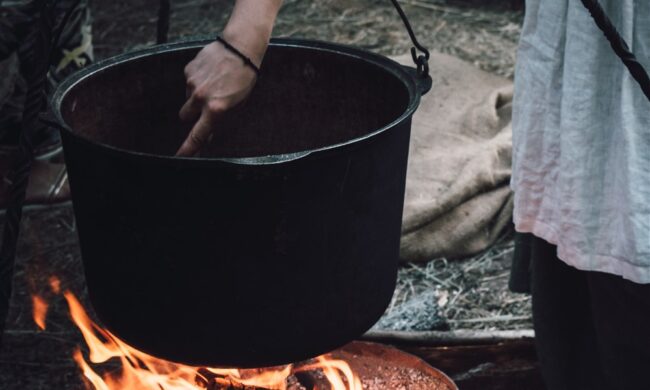***Cauldron*** What images does that word conjur up for you? A genteel picture of a hearty stew brewing over a fire in a medieval hearth? More likely, as a result of some powerfully successful messages imprinted onto our collective unconscious centuries ago, the scene that bubbles up is one of warty-nosed old women cackling around a fire, stirring a steamy concoction of eye of newt, lizard tails, and snake’s teeth. Groan… Will we ever be free of that crass depiction of Shakespeare’s?! Anyone familiar with the earliest representations of cauldrons has to ask: How did one of the most sacred symbols of regeneration become part of such a silly caricature?
Let’s look at a series of flashbacks to begin to answer that question.
Scene 1, (the village of Habasesti in what is now East-central Europe, ca. 4000 BCE)
You are grinding grain, sitting not far from your kiln, a complex cylindrical construction consisting of two vertically arranged parts: a lower section where fuel is burned and an upper section in which the pottery is fired. You are waiting for it to cool, aware of the intense heat that is created, actually exceeding 1000 degrees C. (Gimbutas, p. 123). The vessels that you have created will serve your family and community in important ways: they will be used for long-term storage of oils and grains, preserving the bones and ashes of the dead, and for transforming raw food into cooked You don’t know it, but the development and elaboration of pottery making (the first cauldrons) has been compared to some of the most complex innovations of the technological age– the refinement of crude oil, the adaptation of nuclear energy. (Rich, p.36)
Scene 2 (an Egyptian temple, ca. 1500 B.C.E)
As you enter the temple, you wash your hands in the sacred shi or cauldrons that are placed at the door. These are the same vessels that held the holy water for your temple initiation; other, similar ones will be used in the elaborate rebirthing ritual that you are here to witness tonight. As you wait for it to begin, your eyes fall on one of the glyphs painted on the wall depicting the threefold Creatrix, mother of the Sun, the universe and all the gods — a design of three cauldrons (Walker, p. 150) — yet another reminder that you are in Her womb.
Scene 3 (Iceland, ca. 700 C.E.)
You are gathered around the massive fireplace with your siblings, eager for the evening’s story-telling to begin. You’ve heard them all dozens of times and never tire of the master bard’s renditions. Tonight she will tell the tale of how Odin stole his divine power from the three cauldrons of Wise Blood in the cave-womb of the earth. With wide eyes, you listen as he transforms himself into a serpent and woos the earth-giantess. While she is thoroughly beguiled, Odin drinks the magic blood from the cauldrons, shape-shifts again into a bird and carries the precious blood back to the other gods. (Walker, p.150) Did you know that in India on this very night, children are listening to the almost identical tale of Indra and Kali?
Scene 4 (Wales, ca. 8th century C.E.)
The chanting of the crowd soars in volume and intensity as you slowly make your way down the petal-strewn path toward the sacred grove. Behind you, two novices ride horses, carefully pulling a wooden cart bearing precious cargo — the Cauldron of Regeneration. This vessel represents your people’s central religious mystery: reincarnation within the womb of the Goddess. It is said that dead men could be resuscitated overnight in the cauldron of the Goddess Branwen. Each temple has its own giant cauldron, brought by the fairies, according to local legend. (Walker, p.152) You look around and understand the depth of meaning this ritual has for your people — the Cauldron is a powerful symbol of life, wisdom, inspiration and enlightenment for them. You pray that the whispers of a new law outlawing these processions are false and return your mind and heart to the pageantry surrounding you.
Scene 5 (Germany, ca. 15th century C.E.)
You’ve always felt safe in your tidy little home, sustained by the abundant harvest of your land. Since your husband died 20 years ago, you’ve made a comfortable life for yourself. A gifted healer and midwife, the villagers have come to rely on your warm touch and herbal remedies for all manner of ailments. Dozens of babies that you delivered have grown up healthy and strong under your care. Your neighbors know they will always find a welcome place in front of your hearth where the latest medicinal tea or salve — perhaps for Marta’s ulcerated leg?– bubbles gently in your heavy iron cauldron. But lately, you’ve noticed a subtle difference in how they approach you… a certain reluctance, even suspicion in their eyes. You have your differences with the local priest and know he does not think kindly of your preference to seek the Divine in the majestic forests surrounding your home, rather than on the hard wooden pews in his stuffy church. You’ve heard rumors of terrible accusations, and worse, against midwives in other towns farther down the Rhine. But surely not in your village, surely not to you…
*********
Through these brief historical vignettes, you can begin to get a sense of both the earliest multi-cultural reverence towards the Cauldron as a symbol of transformation and regeneration, as well as its systematic and negative tarnishing over the ensuing centuries. The notion of the Cauldron as container, as womb, resonates particularly with women — reclaiming its powerful imagery is yet another way of re-activating the energy of the Divine Feminine within ourselves and in the world.
References:
Gimbutas, M. (1991). The civilization of the goddess. New York: Harper Collins Publishing.
Rich, A. (1986). Of woman born. New York: W.W. Norton & Co.
Walker, B.G. (1983). Woman’s Dictionary of symbols and sacred objects. New York: Harper Collins Publishing.

